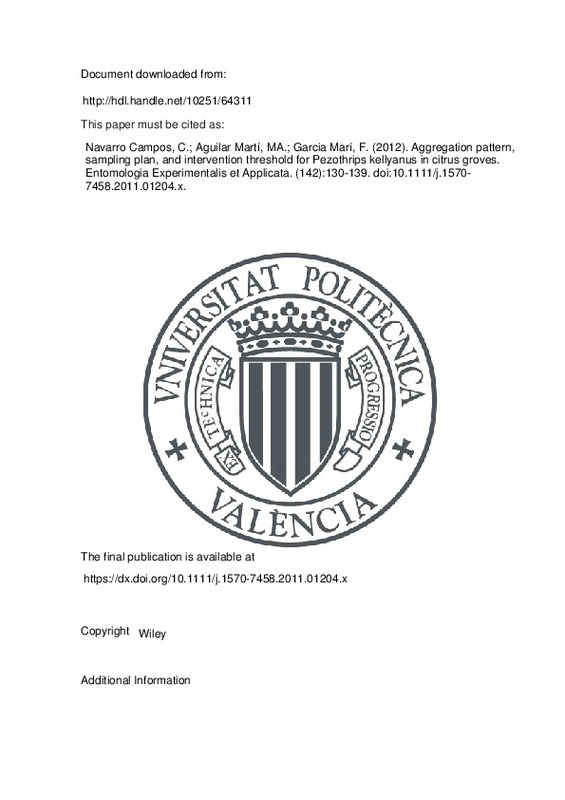Baker GJ 2006 Kelly Citrus Thrips Management. Fact sheet Government of South Australia, primary industries and resources SA http://www.sardi.sa.gov.au/pestsdiseases/horticulture/horticultural-pestskelly-citrus-thrips
Blank, R. H., & Gill, G. S. C. (1997). Thrips (thysanoptera: Terebrantia) on flowers and fruit of citrus in New Zealand. New Zealand Journal of Crop and Horticultural Science, 25(4), 319-332. doi:10.1080/01140671.1997.9514023
Bodenheimer, F. S. (1951). Citrus Entomology. doi:10.1007/978-94-017-5218-3
[+]
Baker GJ 2006 Kelly Citrus Thrips Management. Fact sheet Government of South Australia, primary industries and resources SA http://www.sardi.sa.gov.au/pestsdiseases/horticulture/horticultural-pestskelly-citrus-thrips
Blank, R. H., & Gill, G. S. C. (1997). Thrips (thysanoptera: Terebrantia) on flowers and fruit of citrus in New Zealand. New Zealand Journal of Crop and Horticultural Science, 25(4), 319-332. doi:10.1080/01140671.1997.9514023
Bodenheimer, F. S. (1951). Citrus Entomology. doi:10.1007/978-94-017-5218-3
Childers, C. C., & Nakahara, S. (2006). Thysanoptera (Thrips) Within Citrus Orchards in Florida: Species Distribution, Relative and Seasonal Abundance Within Trees, and Species on Vines and Ground Cover Plants. Journal of Insect Science, 6(45), 1-19. doi:10.1673/031.006.4501
Damos, P., & Savopoulou-Soultani, M. (2010). Population dynamics ofAnarsia lineatellain relation to crop damage and the development of economic injury levels. Journal of Applied Entomology, 134(2), 105-115. doi:10.1111/j.1439-0418.2009.01444.x
Green, R. H. (1970). On fixed precision level sequential sampling. Researches on Population Ecology, 12(2), 249-251. doi:10.1007/bf02511568
Grout, T. G., & Richards, G. I. (1990). Monitoring citrus thrips,Scirtothrips aurantiiFaure (Thysanoptera, Thripidae), with yellow card traps and the effect of latitude on treatment thresholds. Journal of Applied Entomology, 109(1-5), 385-389. doi:10.1111/j.1439-0418.1990.tb00067.x
Iwao, S. (1968). A new regression method for analyzing the aggregation pattern of animal populations. Researches on Population Ecology, 10(1), 1-20. doi:10.1007/bf02514729
Kirk, W. (1987). A Key to the Larvae of Some Common Australian Flower Thrips (Insecta, Thysanoptera), With a Host-Plant Survey. Australian Journal of Zoology, 35(2), 173. doi:10.1071/zo9870173
Kuno, E. (1986). Evaluation of statistical precision and design of efficient sampling for the population estimation based on frequency of occurrence. Researches on Population Ecology, 28(2), 305-319. doi:10.1007/bf02515457
Kuno, E. (1991). Sampling and Analysis of Insect Populations. Annual Review of Entomology, 36(1), 285-304. doi:10.1146/annurev.en.36.010191.001441
Lloyd, M. (1967). `Mean Crowding’. The Journal of Animal Ecology, 36(1), 1. doi:10.2307/3012
MARM 2011 Ministerio de Medio ambiente y Medio Rural y Marino http://www.marm.es
MILNE, J. R., MILNE, M., & WALTER, G. H. (1997). A Key to Larval Thrips (Thysanoptera) from Granite Belt Stonefruit Trees and a First Description of Pseudanaphothrips achaetus (Bagnall) Larvae. Australian Journal of Entomology, 36(4), 319-326. doi:10.1111/j.1440-6055.1997.tb01479.x
Naranjo, S. E., & Hutchison, W. D. (1997). Validation of Arthropod Sampling Plans Using a Resampling Approach: Software and Analysis. American Entomologist, 43(1), 48-57. doi:10.1093/ae/43.1.48
Norton, G. A. (1976). Analysis of decision making in crop protection. Agro-Ecosystems, 3, 27-44. doi:10.1016/0304-3746(76)90098-6
Park, J.-J., Lee, D. H., Shin, K.-I., Lee, J.-H., & Cho, K. (2009). Analysis of spatial and temporal associations of adult and immature Frankliniella occidentalis Pergande (Thysanoptera: Thripidae) in cucumber greenhouses. Applied Entomology and Zoology, 44(4), 569-577. doi:10.1303/aez.2009.569
Pedigo, L. P., Hutchins, S. H., & Higley, L. G. (1986). Economic Injury Levels in Theory and Practice. Annual Review of Entomology, 31(1), 341-368. doi:10.1146/annurev.en.31.010186.002013
Rhodes, A. A., & Morse, J. G. (1989). Scirtothrips citri sampling and damage prediction on California navel oranges. Agriculture, Ecosystems & Environment, 26(2), 117-129. doi:10.1016/0167-8809(89)90022-4
Nava, S. V. E., Funderburk, J. E., Mack, T. P., Beshear, R. J., & Olson, S. M. (1994). Aggregation Indices and Sample Size Curves for Binomial Sampling of Flower-Inhabiting Frankliniella Species (Thysanoptera: Thripidae) on Tomato. Journal of Economic Entomology, 87(6), 1622-1626. doi:10.1093/jee/87.6.1622
Samways, M. J. (1986). Spatial distribution of Scirtothrips aurantii Faure (Thysanoptera: Thripidae) and threshold level for one per cent. damage on citrus fruit based on trapping with fluorescent yellow sticky traps. Bulletin of Entomological Research, 76(4), 649-659. doi:10.1017/s0007485300015145
Steiner, M. Y. (1990). Determining Population Characteristics and Sampling Procedures for the Western Flower Thrips (Thysanoptera: Thripidae) and the Predatory Mite Amblyseius cucumeris (Acari: Phytoseiidae) on Greenhouse Cucumber. Environmental Entomology, 19(5), 1605-1613. doi:10.1093/ee/19.5.1605
Stern, V. M., Smith, R. F., van den Bosch, R., & Hagen, K. S. (1959). The integration of chemical and biological control of the spotted alfalfa aphid: The integrated control concept. Hilgardia, 29(2), 81-101. doi:10.3733/hilg.v29n02p081
TAYLOR, L. R. (1961). Aggregation, Variance and the Mean. Nature, 189(4766), 732-735. doi:10.1038/189732a0
Tekşam, İ., & Tunç, İ. (2009). An analysis of Thysanoptera associated with citrus flowers in Antalya, Turkey: Composition, distribution, abundance and pest status of species. Applied Entomology and Zoology, 44(3), 455-464. doi:10.1303/aez.2009.455
TSUCHIYA, M., TOGAWA, M., FURUHASHI, K., & MASUI, S. (1995). Infestation and Damage Caused by Western Flower Thrips(Frankliniella occidentalis Pergande) on Satsuma Mandarin(Citrus unshiu Marc.). Japanese journal of applied entomology and zoology, 39(3), 253-259. doi:10.1303/jjaez.39.253
Vassiliou, V. A. (2007). Chemical control of Pezothrips kellyanus (Thysanoptera: Thripidae) in citrus plantations in Cyprus. Crop Protection, 26(10), 1579-1584. doi:10.1016/j.cropro.2007.02.004
Vassiliou, V. A. (2010). Ecology and Behavior of <I>Pezothrips kellyanus</I> (Thysanoptera: Thripidae) on Citrus. Journal of Economic Entomology, 103(1), 47-53. doi:10.1603/ec09114
Vierbergen, G., Kucharczyk, H., & Kirk, W. D. J. (2010). A key to the second instar larvae of the Thripidae of the Western Palaearctic region (Thysanoptera). Tijdschrift voor Entomologie, 153(1), 99-160. doi:10.1163/22119434-900000294
Wang, K., & Shipp, J. L. (2001). Sequential Sampling Plans for Western Flower Thrips (Thysanoptera: Thripidae) on Greenhouse Cucumbers. Journal of Economic Entomology, 94(2), 579-585. doi:10.1603/0022-0493-94.2.579
Wilson, L. T., & Room, P. M. (1983). Clumping Patterns of Fruit and Arthropods in Cotton, with Implications for Binomial Sampling. Environmental Entomology, 12(1), 50-54. doi:10.1093/ee/12.1.50
[-]







![[Cerrado]](/themes/UPV/images/candado.png)


